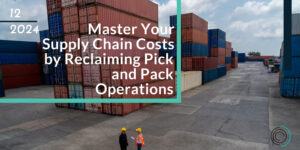Streamlining Success: Unlocking the Power of Collaboration and Innovation in Warehouse Logistics
The critical role of optimizing business operations for warehouse shipping and logistics leaders is absolutely vital in today’s fast-paced market environment. With the ever-growing complexity of the supply chain, these leaders are finding it more necessary than ever to rely on the specialized knowledge and skills of expert professionals. These experts play a pivotal role in crafting innovative strategies that aim to significantly improve warehouse operational efficiency, negotiate better terms in supplier agreements, and provide enhanced oversight and control over every aspect of business operations. This not only helps in staying competitive but also in meeting the evolving demands of customers and the market at large. The collaboration between logistics leaders and these specialized professionals is key to navigating the challenges of the supply chain, ensuring that operations run smoothly and efficiently, and ultimately, securing a stronger position in the marketplace.
As we look ahead, the next five years promise to be a defining period for those at the helm of warehouse logistics. The challenge will be to continuously seek innovative solutions and adopt new technologies that can drive efficiency, reduce costs, and improve overall service quality. This may involve investing in advanced automation technologies, integrating sophisticated data analytics to forecast demand more accurately, or exploring sustainable practices that can also offer financial benefits.
Let’s delve deeper into some of the strategic approaches that can be employed in the coming years. Emphasizing the importance of technology, for instance, could involve implementing cutting-edge warehouse management systems (WMS) to streamline operations. Another strategy might focus on enhancing the workforce’s skills and expertise through targeted training programs, ensuring that the human element of the operation is as efficient and adaptive as the technological aspects.
Additionally, fostering strong relationships with suppliers and exploring collaborative approaches to logistics challenges can lead to mutual benefits, including cost reductions and improved supply chain resilience. This collaborative approach, combined with a keen eye on emerging market trends and customer expectations, will enable warehouse logistics leaders to not just stay ahead of their competition but set new standards in efficiency and effectiveness.
The next five years represent a critical period for leaders in warehouse logistics as they steer their operations through an environment characterized by swift transformations and escalating competition. To thrive in such a dynamic landscape, these leaders must adopt a forward-thinking mindset. This involves not only staying abreast of technological advancements that can significantly enhance operational efficiency but also seeking strategic collaborations that can open new avenues for growth. By carefully and meticulously integrating innovative technologies with strategic and beneficial partnerships, leaders in warehouse logistics can ensure that their operations are not only optimized to meet current challenges efficiently but also lay a robust and solid foundation for sustained success. This forward-thinking approach enables continuous expansion and improvement in the future, positioning these leaders at the forefront of industry advancements and operational excellence. Through this proactive strategy, they can anticipate future trends, adapt to changing market demands, and maintain a competitive edge in a rapidly evolving sector.
Robotics RaaS Technology in Warehouse Logistics
In the fast-evolving landscape of warehouse logistics, one of the key strategies that leaders in the field should seriously consider is the adoption of robotics RaaS (Robotics-as-a-Service) technology. This innovative approach leverages cutting-edge robotics to automate various warehousing tasks, fundamentally transforming how operations are conducted.
The use of robotics RaaS technology marks a significant departure from traditional methods, such as reliance on outdated conveyor belt systems. These older systems are not only less efficient but also require considerable human intervention for maintenance and operation. By contrast, robotics RaaS introduces a level of automation that can effectively replace these old conveyor belts, significantly minimizing the need for human capital to navigate the extensive spans of the warehouse during the critical picking process.
Moreover, robotics RaaS technology is not limited to merely replacing human effort in routine tasks. It extends its utility to streamline a broad spectrum of activities including loading, unloading, sorting, and packing. This automation allows warehouse personnel to redirect their focus toward tasks that demand a higher level of expertise, strategic thinking, and decision-making. As a result, it not only enhances the operational efficiency of the warehouse but also elevates the role of the staff to more cognitively engaging functions.
Additionally, the implementation of robotics RaaS goes beyond operational efficiency. It presents a financially sustainable model by reducing costs associated with traditional labor expenses, such as salaries, training, and benefits. In the long run, this cost-saving aspect of robotics RaaS technology contributes to a healthier bottom line for businesses by boosting productivity and enabling the allocation of resources to areas that can generate greater returns or require more investment.
The integration of robotics RaaS technology within warehouse logistics represents a forward-thinking approach that can lead to substantial improvements in operational efficiency, cost reduction, and overall productivity. By embracing this technology, warehouse logistics leaders can ensure they remain competitive in a market that increasingly demands speed, efficiency, and flexibility.
Supply Chain Management
In the realm of warehouse logistics, a pivotal strategy for leaders to embrace over the next five years is the meticulous management of their supply chains. This involves a deep dive into understanding their current business operations and identifying potential areas for optimization within their supply chains. By doing so, organizations not only stand to enhance their cost-effectiveness but also significantly boost customer satisfaction and profitability.
To achieve these goals, it’s advisable for organizations to consider the adoption of advanced technologies. For instance, AI-driven automation systems and data analytics platforms represent cutting-edge solutions that can empower companies to monitor inventory levels with unprecedented accuracy and in real time. Such technologies facilitate the creation of an agile and responsive supply chain network that can swiftly adapt to changes in demand or supply.
Moreover, the importance of forging strong relationships with reliable suppliers cannot be overstressed. Organizations should aim to partner with suppliers who not only offer competitive prices but also adhere to high standards of quality and service. This ensures that the company can maintain its competitiveness in the market without compromising on the quality of the service levels that customers have come to expect.
In addition to technology investments and supplier relationships, organizations should also focus on training and development programs for their staff to better understand and leverage these new technologies and strategies. By equipping their employees with the necessary skills and knowledge, companies can ensure more efficient and effective supply chain management, further enhancing their ability to meet customer needs and stay ahead in the market.
By meticulously managing their supply chains, investing in the right technologies, maintaining strong supplier partnerships, and focusing on employee development, warehouse logistics leaders can set the stage for substantial growth and success in the coming years.
Negotiating Supplier Contracts
Finally, another strategy that organizations can employ to refine and enhance their business operations over the forthcoming five years involves the critical task of negotiating better supplier contracts. Engaging in thoughtful negotiations with suppliers empowers organizations to secure more favorable pricing on essential materials and services, thereby ensuring access to high-quality products at cost-effective price points. This approach not only aids in maintaining a competitive edge but also underscores the importance of value for money in today’s economy. Furthermore, establishing well-defined terms concerning delivery timescales is crucial. It allows customers to have absolute clarity on when to expect their purchases, thereby enhancing customer trust and satisfaction. Moreover, engaging in negotiations with a variety of suppliers opens avenues for organizations to identify and capitalize on cost-saving opportunities, whilst simultaneously broadening their range of product offerings.
Over the next five years, it will become increasingly crucial for leaders in the fields of warehouse shipping and logistics to proactively and continuously seek out and adopt innovative strategies to significantly enhance their operational efficiencies. Their primary objective is clear: to secure a dominant position in the marketplace and achieve sustained profitability amid an intensely competitive environment. This ambitious goal necessitates the embracement of cutting-edge solutions, such as robotics-as-a-service (RaaS) technology, which offers a modern alternative to outdated conveyor systems, thereby revolutionizing material handling and inventory management.
Furthermore, meticulous management of supply chains becomes paramount, requiring a strategic approach to optimize logistics, reduce bottlenecks, and ensure seamless flow of goods from suppliers to customers. Implementing AI-driven automation across various facets of operations, from order processing to customer service, can dramatically increase efficiency and reduce human error.
Leveraging advanced data analytics is another critical component, enabling organizations to make informed decisions by analyzing trends, forecasting demand, and optimizing resource allocation. Additionally, effectively negotiating supplier contracts can lead to better terms and cost savings, directly impacting the bottom line.
Expanding product ranges to meet consumer demands and exploring new market opportunities are essential strategies for growth and competitiveness. Prioritizing customer satisfaction through improved service delivery and engagement can foster loyalty and positive word-of-mouth, which are invaluable in today’s market.
Moreover, reducing expenses associated with traditional labor—through automation and more efficient operational practices—can significantly cut operational costs. This shift not only improves profitability but also allows reinvestment into other areas of the business, such as research and development or marketing strategies.
This strategic overhaul, encompassing everything from technological adoption to customer service enhancement and cost management, is designed to create a growth-oriented, efficient, and successful operational model. Over the ensuing five years, these comprehensive efforts will prepare businesses to not only survive but thrive amidst the challenges of an ever-evolving competitive landscape, setting a new standard for excellence in warehouse shipping and logistics.
If you’re seeking assistance with your warehouse operations, shipping processes, or overall logistics management, our team is here to help. Visit our “Contact Us” page to learn more about our services and book a consultation today. Let us help streamline your operations for better efficiency and success.







